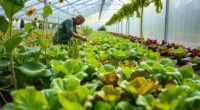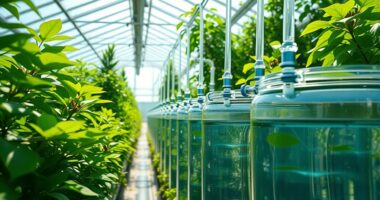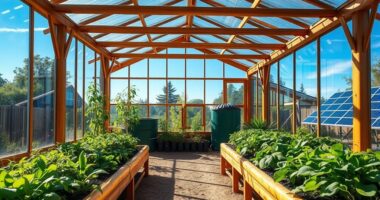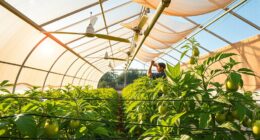Using solar power in your greenhouse helps you save on energy costs while promoting sustainable agriculture. You'll gain energy independence and improve your greenhouse's efficiency, leading to better crop quality and higher yields. With various solar systems available, from passive designs to solar panels, you can find the right fit for your needs. Plus, the environmental benefits are significant. If you want to explore how to implement these solutions, keep going to learn more!
Key Takeaways
- Implement solar panel systems to convert sunlight into electricity, reducing reliance on grid power and lowering utility bills.
- Utilize passive solar design by orienting your greenhouse southward to maximize sunlight exposure for natural heating and cooling.
- Enhance energy efficiency with superior glazing materials and insulation to retain heat and improve growing conditions.
- Incorporate thermal mass elements like water barrels to effectively store and release heat, supporting consistent temperatures.
- Explore government incentives and financing options to make solar power installations more affordable and economically viable.
Benefits of Solar Power for Greenhouses

When you harness solar power for your greenhouse, you unlock numerous benefits that can transform your gardening experience.
First, you'll see significant cost savings as solar energy reduces your reliance on grid electricity, leading to lower energy bills. You gain energy independence, allowing your greenhouse to operate without external power sources, which minimizes vulnerability to outages. Additionally, energy efficiency achieved through renewable solar energy usage can further enhance your greenhouse's performance.
Environmentally, solar power lowers your carbon footprint and reduces pollution, promoting sustainable agriculture.
Enhanced crop production is another advantage; your crops benefit from optimal growing conditions, leading to higher yields and improved quality.
Types of Solar Energy Systems for Greenhouses

What types of solar energy systems can you use in your greenhouse to maximize efficiency and sustainability?
You might consider passive solar greenhouses, which rely on natural sunlight for heating and cooling, cutting down on mechanical systems. Solar panel systems can convert sunlight into electricity, powering your greenhouse operations effectively. If you need heat, solar thermal systems utilize solar collectors to warm water or glycol for radiant heating. For consistent heating, hybrid systems merge solar power with other energy sources. Lastly, solar generators can serve as backup power during low sunlight periods, ensuring your plants stay healthy. Choosing the right system can significantly enhance your greenhouse's sustainability and energy efficiency, contributing to a healthier, sustainable planet.
Designing and Constructing Solar Greenhouses
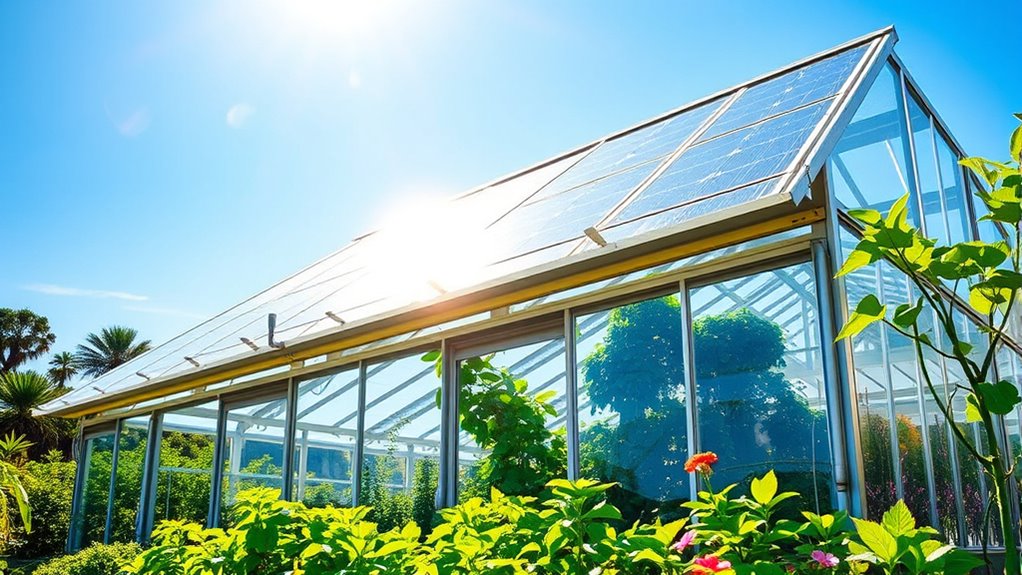
Designing and constructing solar greenhouses involves careful consideration of various factors to optimize energy efficiency and plant health.
Start by orienting your greenhouse southward to maximize sunlight, adjusting for east-west exposure. Insulate northern walls well to minimize heat loss, and consider additional insulation on the east and west sides in colder climates.
Use efficient glazing materials, like polycarbonate panels, for light transmission and heat retention. Incorporate thermal mass elements, such as water barrels, to store heat. The integration of solar panels enhances energy efficiency, providing crucial electricity for your greenhouse systems.
Strategically place vents for natural ventilation, ensuring optimal air circulation. Build on a well-insulated foundation, and design the roof to retain heat in winter while cooling in summer.
Economic Advantages of Implementing Solar Power

Implementing solar power in your greenhouse not only cuts energy costs but also offers a range of economic advantages that can significantly impact your bottom line.
By reducing reliance on traditional energy sources, you'll see lower utility bills and enjoy long-term savings that offset your initial investment. You might also qualify for government incentives and tax credits, making solar more affordable. Additionally, a solar-powered greenhouse boosts your property value and grants you independence from the grid, especially useful in remote areas. With financing options and the potential for net metering, you can further enhance your savings. Moreover, integrating solar power can lead to increased efficiency and long-term savings that further solidify your greenhouse's financial viability.
Environmental Impact and Sustainability of Solar Greenhouses

While the benefits of solar power in greenhouses are clear, it's essential to understand their environmental impact and sustainability.
Solar greenhouses significantly reduce your carbon footprint by minimizing fossil fuel reliance. They promote fewer chemical inputs due to a controlled environment, enhancing sustainability. Additionally, the use of solar panels allows for efficient harnessing and storage of solar energy, which further contributes to reducing dependence on external power sources. Airtight coolers can also be integrated into greenhouse systems to create optimal conditions for plant growth. Furthermore, employing solar energy for heating can lead to significant cost savings over time. Incorporating systems that utilize heat pumps can further enhance energy efficiency and indoor climate control.
However, consider local ecosystems; large greenhouse operations can strain water resources and generate plastic waste.
Innovative designs, like passive solar and semi-transparent solar cells, optimize energy use while benefiting crops.
Despite challenges in material production and disposal, advancements in technology and government incentives support sustainable practices.
Frequently Asked Questions
What Are the Best Locations for Installing Solar Panels on Greenhouses?
When you're choosing the best locations for installing solar panels, focus on south-facing roofs to maximize sunlight absorption, especially if you're in the Northern Hemisphere.
Position the panels at an angle between 30 and 45 degrees for optimal energy capture. Ensure there are no obstructions or shading from nearby trees or buildings.
Depending on your greenhouse design, you might also consider placing panels inside for added protection and efficiency.
How Do Weather Conditions Affect Solar Power Efficiency in Greenhouses?
When it comes to solar power efficiency, weather can really throw a wrench in the works.
Cloud cover and shading significantly reduce solar irradiance, while seasonal changes impact sunlight availability. Elevated temperatures can also lower panel efficiency, but gentle winds may help cool them.
Rain can wash away dust, improving output, yet snow and ice can block sunlight altogether.
What Maintenance Is Required for Solar Panel Systems in Greenhouses?
To maintain your solar panel system, you'll need to clean them two to four times a year, using a soft brush and mild detergent.
Inspect the panels regularly for dirt and damage. Check wiring every six months, tighten bolts, and monitor inverters for errors.
Keep an eye on shading from trees and ensure no debris blocks sunlight.
Consider scheduling annual professional inspections for comprehensive maintenance and follow manufacturer guidelines for optimal performance.
Can Solar Power Systems Be Integrated With Existing Greenhouse Setups?
Imagine your greenhouse as a ship sailing in the sea of energy demands. Integrating solar power systems into your existing setup is like adding wind to your sails.
You can harness the sun's rays to generate electricity, powering your operations efficiently. By strategically placing solar panels, you'll not only cut costs but also gain energy independence.
Plus, it's a step toward a greener future, as you reduce your reliance on fossil fuels.
What Are Common Misconceptions About Solar Energy in Greenhouse Operations?
Many people think solar panels only work in direct sunlight, but they actually generate electricity on cloudy days too.
You might also believe they're too expensive, but financing options can make them more affordable than you think.
Some assume solar panels require constant maintenance, yet they're low-maintenance and durable.
Lastly, there's a misconception that solar energy isn't reliable, but advancements in battery storage ensure you'll have power even during outages.
Conclusion
Incorporating solar power into your greenhouse isn't just a smart move; it's a game changer. By harnessing the sun's energy, you're not only boosting your plants' growth but also cutting costs and reducing your carbon footprint. It's a win-win situation that keeps your operation sustainable and efficient. So, why not take the plunge? Embrace solar energy, and watch your greenhouse thrive while you reap the benefits of a greener future. The sky's the limit!

